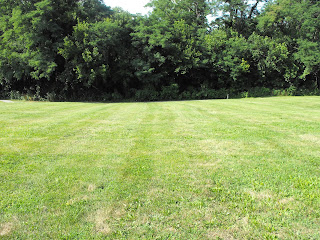Tonight we are camped at Lake Maloney Reservoir State Park, North Platte, Nebraska. We are camped on the bank with only electric hook-up. The campground is only about one-third filled and we just drove into a vacant campsite, set up camp, and deposited our money.
Campsite at Lake Maloney Reservoir State Park
This morning we visited Rock Creek Station historic site before it opened to the public. However, the grounds and buildings are open from early dawn-to-dusk time and is a self-guided tour.It was established in 1857 by S. C. Glenn along the Oregon Trail and the California Trail, along the west bank of Rock Creek. The station was a supply center and campground for emigrants who purchased supplies and other services such as, blacksmithing. In March 1859, the property was purchased by David McCanles and his brother, James, who added a toll bridge across Rock Creek, charging each wagon from 10¢ to 50¢ to cross the bridge depending upon their ability to pay. Also, it is perhaps best known as the place where Pony Express stock-tender "Wild Bill" Hickok gunned down three men. The reconstructed buildings, pioneer graves, and deep ruts carved by the wagon trains give visitors an appreciation of pioneers along the trails.
Perhaps this is what many pioneers saw when they started coming down the trail into the valley.
Original path of trail ruts into Rock Creek
Original site of Toll Bridge
Some of the reconstructed buildings at Rock Creek
Our Casita camper is better than this wagon!
Wild Bill Hickok article
Is this Santa's summer job?
Next we visited Fort Kearney at Kearney, Nebraska. It was founded in 1848 and was the first Western military post built to protect emigrants on the Oregon Trail, and it later served as the headquarters for a number of small outposts along the trail. Also, it was a home station for the Pony Express, a place where travelers could re-supply, an outfitting depot for Indian campaigns and home of the Pawnee Scouts. After archeological exploration the stockade, parade grounds and blacksmith shop have been rebuilt.
Historic Marker at Fort Kearney
Rebuilt blacksmith shop at Fort Kearney
Rebuilt storage building used for guns and gun powder.
Buildings have been identified and marked within the fort.
Also, we visited the Great Platte River Road Archway Monument located directly over Interstate 80 east of Kearney, Nebraska. It is a museum of and monument to Nebraska's and the Platte River valley's role in westward expansion. It pays tribute to the pioneers who passed through this region of Nebraska on their way West.
Great Platte River Road Archway Monument
Then we visited the Pony Express Station in Gothenburg, Nebraska. The Sam Machette Station was used as an early fur trading post/ranch house along the Oregon Trail southwest of Gothenburg before it was used as a Pony Express station during its operation between April 1860 and November 1861. The Pony Express carried mail between St. Joseph, Mo., and Sacramento, Calif. In 1861, the telegraph put an end to the Pony Express. The Pony Express operated for only eighteen months and it is said that only one piece of mail was ever lost during its operation.
Pony Express Station in Gothenburg, Nebraska

























































